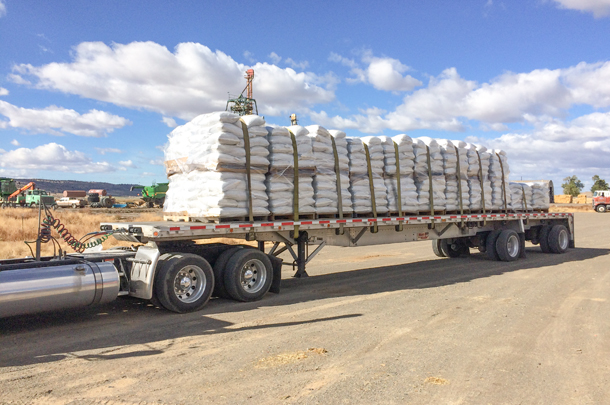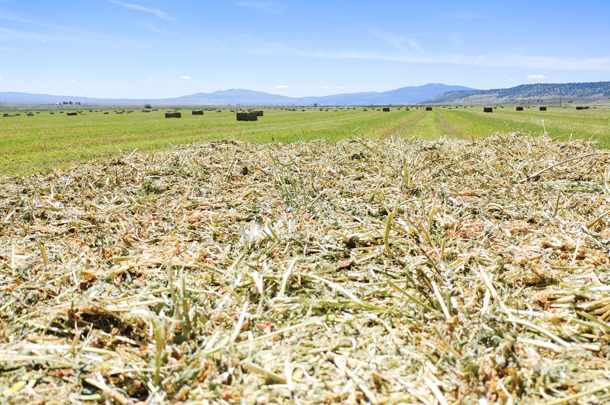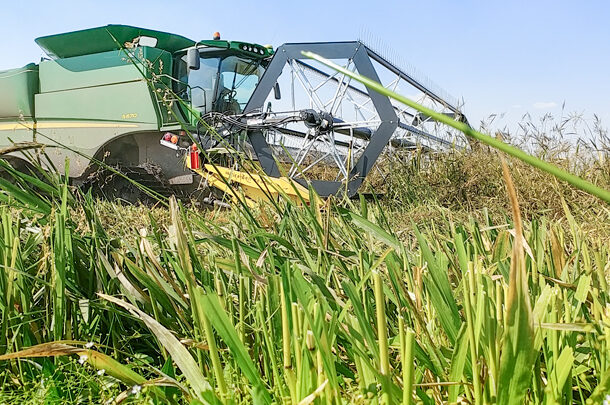Alturas’ management associate, Davis Behle, is a recent University of Nebraska graduate who joined Alturas a year and a half ago to work on soil health. The ranch relies on its alfalfa stands to fix nitrogen, rendering the soil hospitable for high-quality grain production when those crops come into rotation.
Cover cropping is one tool Behle is using to improve soil health and hopefully alfalfa yields over time. Alturas worked with Green Cover Seed in Bladen, Nebraska, to come up with a custom cover-cropping mix for different farm and pasture stands.
“That’s one thing I’ve learned [on cover cropping], is to ask, ‘What is the resource concern you’re trying to address?’” Behle says.
“Some pieces of ground we wanted to improve were compacted, high-alkali and low in organic matter,” Behle says. “We chose cover crops that could withstand alkalinity and add biomass to bring up the soil’s organic matter.”
He describes a scene that will probably sound familiar to a lot of farmers: You have a lush alfalfa stand with dry, barren corners. Behle says they’re using cover crops to break through compaction and to add organic matter to the soil, which, they hope, will bring those problem spots back into production over time.
Alturas is using three different cover-cropping seed mixes, each targeted at addressing different challenges on the ranch.
“One seed mix was for interseeding in our irrigated pastures. What we’re trying to do there is to boost the production of those pastures by adding legumes and other forbs to fix nitrogen and increase plant diversity. A lot of those legume roots can also get through sod-bound and compacted soil.”
Each custom-blended, cover-cropping mix works like a prescription for soil health. The added bonus was providing additional feed for Alturas’ livestock division. (Their most popular cover-cropping mix for shoulder-season grazing is heavy on brassicas, broadleaf plants and annual grasses – plants like kale, turnips, barley and millet.)
Alturas’ livestock and farming divisions have traditionally operated as separate entities, Behle explains. He and Alturas’ ranch manager, Hunter Current, are working together to use the ranch’s livestock as a progenitor of soil health.
“We’d like to use the livestock as a tool to regenerate the land and keep it for grazing, or for returning it to crop production,” Behle says.
When Current joined the ranch five years ago, plugging into the soil health movement was a big priority for him. With help from the nearby Jefferson Center, Current got schooled in the Savory method of land stewardship, and they’ve started to implement holistic grazing practices with their cattle herd.
“The agencies we work with on our permits have been very receptive and cooperative,” Current says. “At first there was some skepticism. It’s new. They’re so used to working with cattlemen who are ‘profit, profit, profit.’”
Current’s stance might be described as a long-term approach to profitability – if Alturas cares for the land first, it should pay them back in returns like increased water-holding capacity and increased grass over time.
That kind of business savvy is part of what keeps Alturas a mainstay of the California hay industry.
“California is being planted in nuts and grapes and fruits – permanent crops over alfalfa crops. We see it as an opportunity,” Current says. Permanent crops aren’t easily turned back into forage production. With the market shift, Alturas has started pursuing the local hay market with more fervor.
“We made a tremendous switch around three years ago with our big bales,” Current says. Up to that point, Alturas made exclusively large bales – mostly destined for large California dairies and export markets.
“We’re doing smaller bales for retail markets again, and ramping up that production,” Current says.
Another unique market Alturas has a hand in is hay pellets. “It’s a great way of putting hay into a different package,” Current says.

The ranch’s pellet mill was an existing asset when Current’s family, the Swensons, took over ownership some 20-odd years ago. The mill had been set up to do cubes for the Japanese and Korean markets. These days, most hay compaction happens closer to the ports, Current explains. They resurrected the mill after seeing a market opportunity for their lower quality hay that didn’t meet muster for dairies. Today, those hay pellets get sold through brokers and agents, and eventually end up in small animal pet feed. Customers can also buy alfalfa pellets direct from Alturas.
The ranch manages its alfalfa stands on seven- to eight-year cycles, and grain crops (wheat, triticale and oats) on a two-year cropping cycle. Much of the grain is for hay, but Alturas sells the highest quality grain for human consumption too (last year, 15 rail cars full).
The third staple crop at Alturas is wild rice. Unlike white rice, wild rice is black and somewhat of an artisanal product. Current likens it to the “quinoa of North America.” Its price varies from $5 to $20 per pound, and Alturas is chasing the latter end of that price spectrum. They recently inked a direct-to-market rice product in hopes of establishing themselves as a frontrunner in California-grown wild rice. The brand name is Sandhill Wild Rice, a nod to the leggy, red-headed bird that uses the ranch as a stopover on its flyway. Current says the rice stands take a little more development, and they stay in production for five to 10 years.
But all that progress on quality grains and wild rice – it all comes back to the alfalfa.

Geography makes Alturas uncannily well-suited to alfalfa production. The 31,000-acre ranch is split between two main properties with about a 1,000-foot elevation difference between them.
“That’s something that’s unique about our operation that I don’t think many others can replicate,” Current explains. “The change in elevation offsets our production cycle, so we’re keeping productivity going all season long.”
Alturas will take three or four cuttings off its lower-elevation ranch and two to three cuttings off the higher one. A harvest crew (up to 90 people during peak season) bumps back and forth between the two ranches all summer. The staggered crop means something is always ready to harvest.
Looking forward, Current is upbeat about where Alturas is headed. The ranch has its challenges – wildfire, water legislation and the constantly changing status of California labor law – but Alturas is gunning to stay ahead of the curve by direct marketing what products it can and managing their land with a focus on long-term health. ![]()
Monica Gokey is a freelancer and livestock producer based in Idaho.
PHOTO 1: Two different ranch sites at an elevation difference of 1,000 feet means Alturas’ harvest crew runs nonstop during the summer.
PHOTO 2: Alturas Ranches has a pellet mill on-site. Pellets leaving the mill are destined for small animal feed.
PHOTO 3: Between grain and wild rice production, hunting permissions and cattle, Alturas is very well diversified. But alfalfa is the ranch’s green gold. Photos courtesy of Alturas Ranches.









